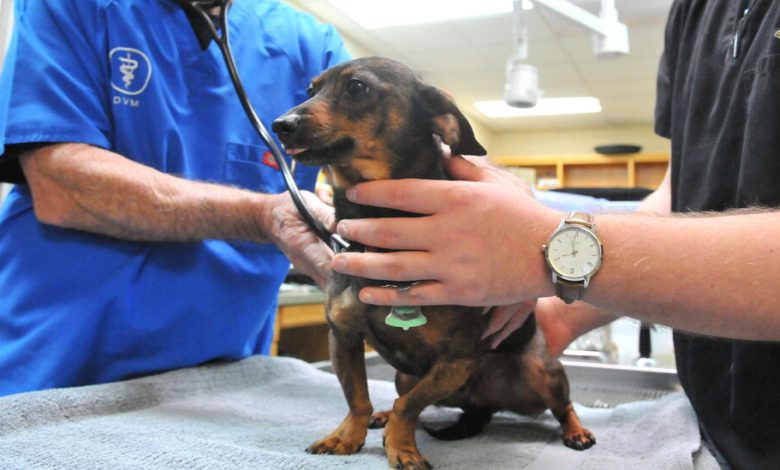Dog Flu Is Back, Too

When a few dogs started coughing at a Texas animal shelter in October, veterinarians were not initially alarmed. The shelter, Operation Kindness, had seen its share of sick dogs.
But these coughs seemed to linger, and the handful of hacking dogs soon turned into dozens. By mid-November, 86 percent of the shelter’s roughly 150 dogs were ill.
“This was just so fast-acting,” said Ed Jamison, the chief executive of Operation Kindness.
Laboratory testing revealed that the dogs had contracted a highly contagious strain of canine influenza, known as H3N2, which has caused a spate of recent outbreaks across the South. Veterinarians have warned clients about the virus on social media, doggy day care facilities have closed and shelters, including Operation Kindness, have suspended adoptions.
The virus, which has caused periodic outbreaks in the United States since 2015, does not currently pose a risk to humans, experts stressed, and most dogs that contract it do not become severely ill. But the disease can progress to pneumonia, or even be fatal, in a small percentage of dogs.
Although canine influenza can flare up at any time, the recent rash of cases could be fueled, in part, by recent changes in Americans’ behaviors, some veterinarians suggested. Shelters that emptied out during the pandemic are full again, they said, and the resurgence of travel and reopening of offices means that more dogs are spending time together in kennels and at day care, where the virus can easily gain a foothold.
“We had a bit of a quiet period during the first couple years of Covid,” said Dr. Silene St. Bernard, the regional medical director for Southern California at VCA Animal Hospitals. “While people were home, their pets were home. And we didn’t see as many of these contagious viruses spreading around.”
Experts are urging dog owners to remain alert for symptoms — which may include coughing, fever and loss of appetite — especially if the virus has been reported in their area. And those whose dogs spend time in social settings may want to consider a canine influenza vaccine.
“You need to think about what risks you take,”said Edward Dubovi, a virologist at the Cornell University College of Veterinary Medicine who was part of the team that identified the first strain of canine influenza.“If you go to a dog park — we have one here in Ithaca, and there may be 30 or 40 dogs running around in there — that’s a risk. If that’s part of your daily routine, and flu is in the area, then you just might want to go get a vaccine.”
There are two strains of canine influenza. The first, known as H3N8, originated in horses and was first detected in Florida among greyhounds in 2004.
But the most recent outbreaks have been caused by H3N2, which originated in birds. It was initially detected in dogs in South Korea in 2007, although it began circulating earlier, and spread in several countries in Asia.
In 2015, it showed up in Chicago, tearing through kennels, veterinary clinics and animal shelters. “In the shelter setting, flu is not super subtle because it comes in like a tidal wave,” said Dr. Sandra Newbury, who directs the University of Wisconsin Shelter Medicine Program. (Dr. Newbury, who was part of the team that responded to and studied the Chicago outbreak, has also been working with Operation Kindness in recent weeks.)
The virus spread through the Midwest and seeded additional outbreaks across the country before eventually fading out.
H3N2 has been reintroduced to the United States numerous times since, research suggests. (Regulations surrounding the importation of dogs are “minimal,” said Dr. Dubovi, adding that the Healthy Dog Importation Act, introduced in Congress last year, would impose more safeguards.)
Canine influenza, which is transmitted through respiratory droplets and aerosols, tends to spread quickly in group settings and can jump between states as infected dogs travel.
“There’s a tendency to move animals from one part of the country to another, or from one shelter to another,” said Colin Parrish, a virologist at Cornell’s College of Veterinary Medicine and an expert on canine influenza. “So the virus gets moved along with the dogs.”
Last year, the virus took hold in Los Angeles, resulting in more than 1,300 cases from July 2021 to January 2022.
This summer, it showed up in Birmingham, Ala. “And it exploded,” said Dr. Lindy Alverson, the chief veterinary officer at the Greater Birmingham Humane Society. “Day cares were closing, groomers were closing.”
The Humane Society, which suspended canine adoptions for six weeks, had to euthanize several severely ill dogs before the outbreak ebbed, Dr. Alverson said. Now, after a brief respite, the virus is back, she added.
Cases have also been reported in Tennessee, South Carolina, Texas and elsewhere, experts noted.
And influenza is not the only respiratory infection making the rounds. In Charlotte, N.C., veterinary facilities and doggy day cares said that they had seen a surge of coughing, sniffling dogs this fall. “By mid-October it got really bad,” said Kim Lovingood-Owens, the co-owner of NoDa Bark and Board. “We closed for an entire week, sanitized the building.”
Some local dogs have tested positive for flu, while others have contracted different respiratory pathogens, such as the bacteria Bordetella bronchiseptica.
In recent weeks, Charlotte Animal Referral & Emergency, a veterinary hospital, has seen a flood of dogs with respiratory infections resulting in severe pneumonia. “We are running out of room to place animals, we’re running out of oxygen to put them on,” said Dr. Kelly Lang, an emergency and critical care veterinarian at the facility. “I’ve never dealt with anything like this before.”
At Operation Kindness, the peak of the outbreak has passed with no canine deaths, although some dogs are still finishing up their courses of treatment, Mr. Jamison said. Last weekend, adoptions at the shelter resumed, and 21 dogs found new homes.
“It was so nice to finally see some dogs get adopted,” Mr. Jamison said.
